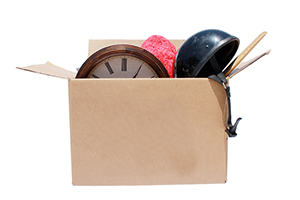
When we clutter our homes and offices, we usually come across objects that we have thought about getting rid of dozens (maybe hundreds) of times, yet never did.
Newton’s First Law of Motion can explain how clutter lingers in our spaces for much longer than it is necessary. An object (clutter) will stay at rest until a force (motivation) of equal or greater value acts upon it. The thought, “I should get rid of that,” is not a force of equal or greater value than the clutter. As unfortunate as it may be, thoughts alone cannot move clutter. We simply cannot wish away our unwanted objects. We actually have to DO something, take action in a very literal sense.
The other case of Newton’s First Law also applies here. An object (me) will continue in motion until a force (motivation) of equal or greater value acts upon it. Usually when we see clutter, it is while we are preoccupied by some other task or thought. We are on a path to take care of the immediate need, like quenching our thirst or answering the phone; not to stop and deal with clutter. Then later, we might think about it again only to be on a different path, like in the shower or driving to work. The motivation to clear the clutter was not equal to or greater than whatever else it was we wanted to be doing.
The only way to deal with the clutter in our lives is to break the patterns of inertia, and create the motivation to do something about all the stuff we do not want or need.
Surprisingly, the best way to create motivation (force) of equal or greater value to change the course of our clutter is to simply acknowledge that we have the power (velocity) to change the situation. We have to move beyond simply thinking “I need to get rid of that,” and take the action necessary to get rid of the object once and for all. Knowing that the object will not move itself and requires a force to act upon it can go a long way in helping you to clear the clutter you encounter regularly in your life.
It can be helpful to have boxes strategically placed around your home in which to collect these items: laundry room, garage, at the base of the stairs or in your closet. Have a designated box for items to be returned to other people or simply given away. It should be in a location where you see it on the way out of your home, a box for items you wish to sell, which should be small, and a box for charitable donations. Everything else can go into the recycle bin or the trash can. When you come across a piece of clutter, pick it up and carry it to the appropriate box, even if it is a little out of the way. When one box is full, deal with all of the boxes.
The easier your system to handle clutter, the less force (motivation) it takes to get the unwanted objects (clutter) out of your home.
Neatly,
Jennifer Snyder, Certified Professional Organizer
Neat as a Pin Organizing Experts
